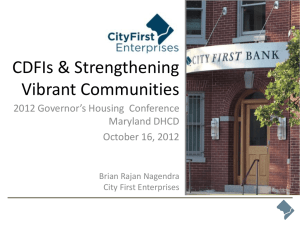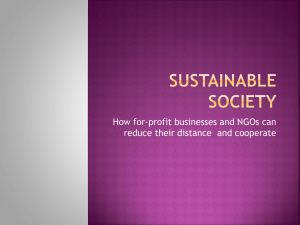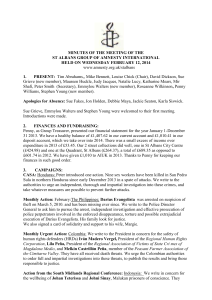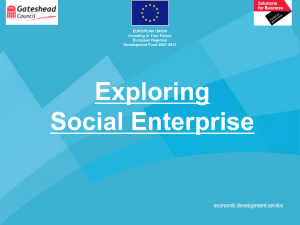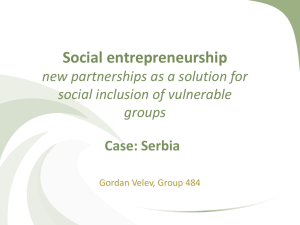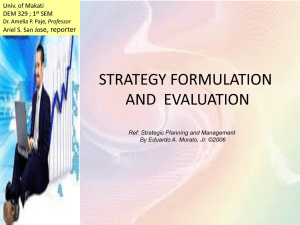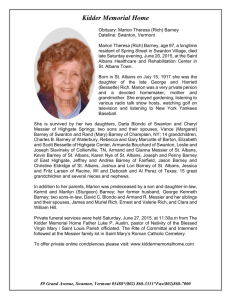Our Place Our People presentation - St. Albans and District Local
advertisement
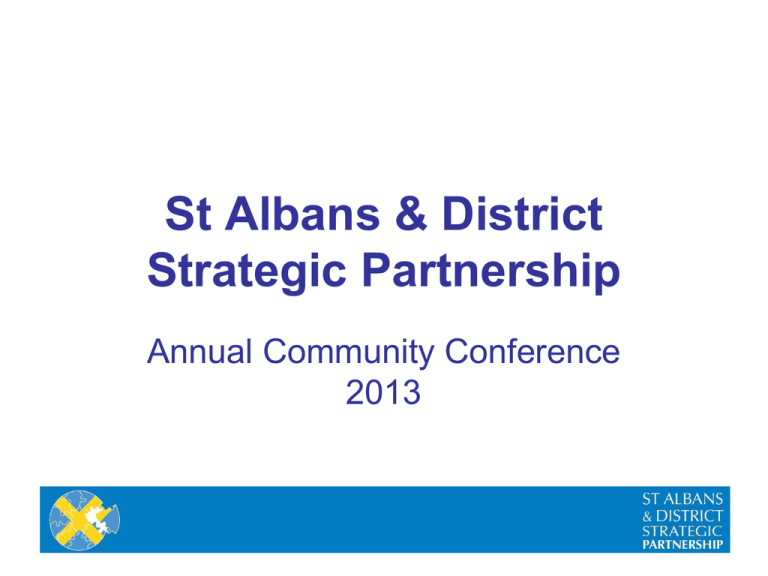
St Albans & District Strategic Partnership Annual Community Conference 2013 Welcome Councillor Julian Daly Chair, St Albans & District Strategic Partnership Executive Leader, St Albans City & District Council Creating value in your Community Temi Odesanya Membership Officer What is social enterprise? • Businesses driven by social and/or environmental purpose, as set out in their governing documents • Trading organisations • Reinvest at least half their profits towards their social mission • Are accountable and transparent • Inclusive governance structures • Assets are often locked for community benefit The Big Issue: A magazine supporting homeless people Divine Chocolate: A chocolate company working with worker coops in Ghana Hill Holt Wood: Preserving an ancient woodland and providing education programmes Sandwell Community Caring Trust: a social enterprise delivering adult social care What is social enterprise? Snapshot of the sector • No. of social enterprises in the UK = 70,000 • Total annual income = £54.9 billion • Contribution (GVA) to the UK economy = £18.5 billion • Employing 973,700 people • Optimism for future growth. Social Enterprise UK • Established in 2002 as the national body for social enterprise (as a coalition) • Membership organisation: almost 700 members; reach to over 10,000 • Board of 10 people – all CEOs of social enterprises • Council of 50 – elected by members – represent different sectors and geographical regions • Funded by a mix of contracts, grants, sponsorship, member fees and paid-for services “Members at the heart....” • • Established in 2002 as the national body for social enterprise (as a coalition) Board of 10 people – all CEOs of social enterprises • Council of 50 – elected by members – represent different sectors and geographical regions • Funded by a mix of contracts, grants, sponsorship, member fees and paid-for services • Membership organisation: over 600 members; reach to over 10,000 • Social enterprises, charities, private businesses • Main purposes: • Supporting social enterprises to thrive • Developing the evidence base for social enterprise • Influencing policy and political agendas • Showcasing the benefits of social enterprise • Broker, facilitator, market builder What we do at SEUK • Create environment for social enterprise to thrive • Research – establish evidence-base for social enterprise • Develop policy • Showcase examples of social enterprise • Create information, tools, guides, training, mentoring, infodevelopment • Broker, facilitator and market builder • Build networks through events and specialist forums • Strategic relationships with every govt departments Who are our stakeholders? • Social enterprises • Businesses and public bodies that want to support them • Local and national Government • EU and international partners • Media; academics; researchers • Consumers and taxpayers • Beneficiaries of social enterprise (= everyone!) Main social and/or environmental objectives Inside social enterprises • 52% of social enterprises actively employ people who are disadvantaged in the labour market (e.g. Long-term unemployed, ex-offenders, disabled people) • 84% of social enterprises recruit staff locally • 87% of respondents indicated that their organisation actively aimed to minimise its environmental impact • Double the number of social enterprises expect the numbers employed to increase compared to SME’s Community Development Thank you! Any questions... www.socialenterprise.org.uk @SocialEnt_UK temi.odesanya@socialenterprise.org.uk Changing demographics of the District Paul Howes Policy and Performance Manager Population: What has changed? 153,123 Recent trend equivalent to: ≈1,300 people a year 1981 1991 2001 2011 2020 Population: Where has the population grown? Age: What has changed? Lower proportion of 20 - 39 year olds Higher Proportion of 40 - 49 year olds Higher proportion of 0 - 10 year olds Higher Proportion of 60 - 69 year olds Age (under 5’s): Where has it changed? Age (60-64): Where has it changed? Ethnicity: What has changed? White Mixed 2001 2011 Asian/ Asian British Black/ Black British Other Ethnicity: Where has it changed? General increase in non-white residents in the district, the map illustrates the areas of greater growth Health: What has changed? N.B. different answer options in 2011, not directly comparable Health: What has changed? Health: What has changed? Health: Where is the very bad or bad health? Education: What has changed? Education: What has changed? Education: Where has it changed? Employment: What has changed? Professional occupations - 8th highest rate in England Managers, Directors and senior officials - 16th highest rate in England Associate Professional and technical occupations - 20th highest rate in England Employment: Professional occupation Unemployment data • Number of people claiming Job Seekers Allowance in the St Albans City and District is 1,280 people or 1.4% (September 2013). • This is 46 people fewer than the previous month and 280 fewer than September 2012. • The District is the lowest rate in the County and joint 50th lowest rate in England (out of 326 local authorities). Sep 12 Oct 12 Nov 12 Dec 12 Jan 13 Feb 13 Mar 13 Apr 13 May 13 Jun 13 Jul 13 Aug 13 Sep 13 1.8% 1.7% 1.7% 1.6% 1.7% 1.8% 1.7% 1.6% 1.6% 1.5% 1.5% 1.5% 1.4% Economic Development Priorities Community Survey – Headlines Higher or Lower is better Place Survey 2008/09 Community Survey 2010/11 Community Survey 2012 Improvement since 2010/11 % of people who believe people from difference backgrounds get on well together in their local area Higher 85.3% 81.4% 86.8% Yes % of people feel that they belong to their local area/ neighbourhood Higher 59.9% 66.7% 73.9% Yes Satisfied with your local area as a place to live Higher 90% 90% 94% Yes Satisfied with the way that St Albans City and District Council runs things Higher 42% 54% 70% Yes Overall/ general satisfaction with local area Higher 90.3% 90.1% 93.6% Yes Who feel they very and fairly strongly belong to their neighbourhood Higher 60% 67% 74% Yes Perceptions of anti-social behaviour Lower 10.1% 11.1% 4.8% Yes Self-reported measure of people’s overall health and wellbeing Higher 84.0% 84.5% 85.4% Yes Community Survey – Headlines Higher or Lower is better Place Survey 2008/09 Community Survey 2010/11 Community Survey 2012 Improvement since 2010/11 Civic participation in the local area Higher 15.5% 16.2% 14.8% No % of people who feel they can influence decisions in their locality Higher 26.7% 33.7% 26.5% No Participation in regular volunteering Higher 29.4% 31.8% 26.4% No Thank you for listening Active Listening Workshops Population changes - Conference room Health- Conference room Employment and growth- Elliot suite (upstairs) Education - Yates suite (upstairs) David Lloyd Police and Crime Commissioner, Hertfordshire Emerging themes from break out sessions James Blake Chief Executive, St Albans City and District Council General points • Comparing surveys with service data • Analysing and targeting individual places and groups • Data informing difficult financial choices Population • Impact on housing need – not just numbers but type and affordability • Population growth creates economic potential but service pressure • Growth in younger and older people - greater proportional service demand • Need to ensure 20-39 year olds can thrive in the District Employment and growth • Maximising potential of the professional population • Linking successful businesses to the community • Involving businesses in identifying and addressing skills gaps • Education - Yates suite (upstairs) Education • Good analysis needed on timing, location and impact of new school places • Positive routes for less academic young people – helps to fill skills gaps • Tackling skills gaps across all generations • Strengthen school/college links with local business and communities Health • Greater analysis/data on specific health issues and causes e.g. Mental Health • Health data should inform voluntary services as well as statutory services • Strengthen the links between GPs and local community initiatives Next steps • Draw together the comments from the active listening sessions • Consideration by the Strategic Partnership • Comments used to shape the analysis, priorities and work programme Reflections Councillor Julian Daly Chair, St Albans & District Strategic Partnership Executive Leader, St Albans City & District Council



